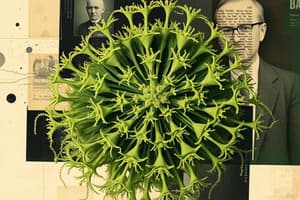Podcast
Questions and Answers
What is the primary pigment responsible for the green color of chlorophyceae?
What is the primary pigment responsible for the green color of chlorophyceae?
- Chlorophyll b
- Chlorophyll a (correct)
- Carotenoids
- Chlorophyll c
What is the function of pyrenoids in chlorophyceae?
What is the function of pyrenoids in chlorophyceae?
- Cell wall formation
- Starch storage (correct)
- Protein synthesis
- Photosynthesis
What is the composition of the outer layer of the cell wall in chlorophyceae?
What is the composition of the outer layer of the cell wall in chlorophyceae?
- Chitin
- Cellulose
- Pectose (correct)
- Protein
What is the mode of vegetative reproduction in chlorophyceae?
What is the mode of vegetative reproduction in chlorophyceae?
What is the type of spores produced during asexual reproduction in chlorophyceae?
What is the type of spores produced during asexual reproduction in chlorophyceae?
What is the type of reproduction that shows considerable variation in chlorophyceae?
What is the type of reproduction that shows considerable variation in chlorophyceae?
Flashcards are hidden until you start studying
Study Notes
Characteristics of Chlorophyceae (Green Algae)
- Members of Chlorophyceae are commonly known as green algae.
- The plant body can be unicellular, colonial, or filamentous in structure.
Chloroplasts and Pigments
- Chlorophyceae contain chloroplasts, which are the sites of photosynthesis.
- Chloroplasts may have various shapes, including discoid, plate-like, reticulate, cup-shaped, spiral, or ribbon-shaped.
- Chlorophyll a and b are the dominant pigments, giving them a grass green color.
Storage Bodies and Nutrition
- Most Chlorophyceae have pyrenoids, storage bodies located within chloroplasts.
- Pyrenoids contain protein and starch.
- Some species may store food in the form of oil droplets.
Cell Wall Composition
- The cell wall of Chlorophyceae consists of an inner layer of cellulose and an outer layer of pectose.
Reproduction
- Vegetative reproduction occurs through fragmentation or spore formation.
- Asexual reproduction involves the production of flagellated zoospores in zoosporangia.
- Sexual reproduction exhibits variation in the type and formation of sex cells, including isogamous, anisogamous, and oogamous types.
Examples of Chlorophyceae
- Common examples of green algae include Chlamydomonas, Volvox, Ulothrix, Spirogyra, and Chara.
Studying That Suits You
Use AI to generate personalized quizzes and flashcards to suit your learning preferences.




